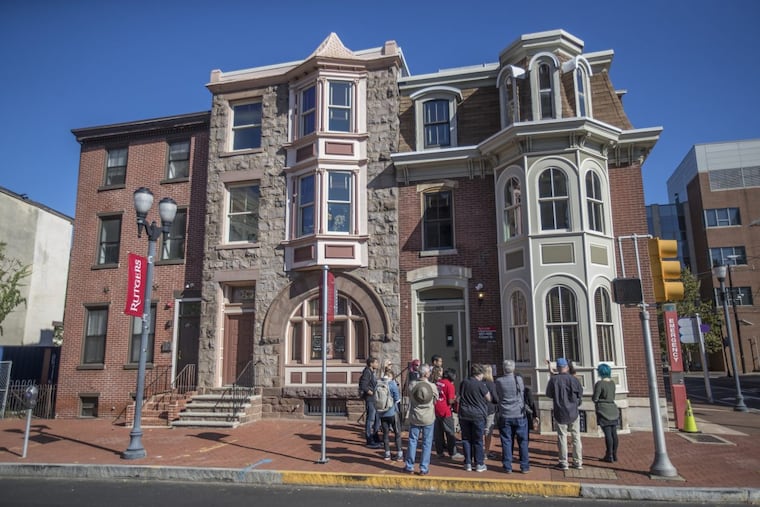How far can the revival of Camden's Cooper Street go? | Kevin Riordan
Cooper Street, once among Camden's finest addresses, is lately showing signs of rebirth.

The history of Cooper Street is the story of Camden — the tale of a city's rise, fall, and fledgling revival.
That's the narrative Miranda Powell and Mikaela Maria offered a diverse group of a dozen city dwellers and suburbanites who took a closer look at the storied downtown thoroughfare during a tour Sunday focused on architecture and historical significance.
"I've walked past these buildings for years when I was going to school here. It's important to know the backstory," said Cherry Hill businesswoman Benniemae Lewis, a 2005 Rutgers graduate.
Said photographer and Rutgers sophomore Austin Cuttino, of Voorhees: "I didn't know a lot about these buildings, and this is a chance to wander around Camden and take photos."
With its roadway freshly paved, trees still leafy green, and eclectic array of buildings aglow in the autumn sun, the street named for the city's pioneering Quaker family was looking rather swell Sunday morning. Tour participants were encouraged to make sketches and take photos, and several vowed to come back.
"The city is always changing, and Cooper Street is representative of those changes," said Powell, curator of the excellent "Picturing Camden" exhibit in the Stedman Gallery at the Rutgers-Camden Center for the Arts. The center sponsored the tour with the university's Mid-Atlantic Regional Center for the Humanities (MARCH), which is researching the life of Cooper Street.
Citing dramatic 1980s photographs by Ken Hohing that are showcased in a portion of the exhibit, Powell noted that while some parts of Camden look "the worse for wear" in recent decades, others "look much better now."
Indeed: In one particularly post-apocalyptic photo, Johnson Park at Second and Cooper looks like a piece of ruin porn.
But the park is now a deep green jewel of public space graced with restored sculptures and architectural amenities.
Several tour-takers said they were pleasantly surprised by the renewed vitality along Cooper Street, which in the last century has shifted from posh residential, to industrial and professional, and more recently, educational, uses. The street reached bottom in the 1980s, after its eastern blocks were lost to urban renewal and several architecturally distinguished homes were abandoned or demolished.
"It's magnificent what they've done here," said Cherry Hill resident Sara Gilgore, who grew up in Parkside and attended Rutgers-Camden in the 1970s.
"I'm thrilled to see the enormous presence of Rutgers."
Indeed, Cooper Street had been nearly moribund for decades until Rutgers-Camden emerged from its once rather cocoon-like campus in a big way nearly 20 years ago. Other educational institutions, including Rowan University, Camden County College, and the LEAP charter schools, also boosted the area with new or renovated buildings.
The tour began at the busy intersection of Fifth and Cooper, an apt choice, given that its four corners are home to a jazzy new Rutgers academic building; a 19th-century mansion repurposed as the home of the university's history department; a magnificent church built in 1892; and a vacant lot where the sad Plaza Hotel stood vacant for nearly 30 years.
Built during the city's 1920s heyday, shuttered in 1985, and demolished in 2015, the Plaza could be said to embody the history of the street and the city, as well. Other important Cooper Street structures, such as the Reinboth-Hatch house and KSU fraternity house, also were replaced by cheap-looking structures, or nothing at all.
But I've also seen Cooper Street landmarks hanging on — such as the majestic Tabernacle of Faith church, where Deacon Eric Thompson graciously allowed the tour to go inside.
I've seen beautiful, grand but long-vacant residences transformed into the Writers House and Alumni House projects, recently completed by Rutgers on opposite sides of Cooper near Third Street.
And I'm dying to see the Pierre apartments, where the classic art deco facade has been obscured for a year as a $7 million renovation project continues.
"It was a hotel, built in 1932," Maria Del Mar Lopez, one of the partners in M&M Development, said by phone Monday. "We're converting it into 32 apartments, seven of them affordable, the rest market rate."
Lopez, whose firm has built and renovated residential projects elsewhere in downtown Camden, said Cooper Street is an ideal location "to create units for people who are coming into Camden to work, so they can live in Camden."
With other development projects rising all over town and the city expected to make a play for Amazon's second headquarters, Cooper Street matters more than ever. It survived the urban renewal frenzy of the 1960s and '70s substantially intact, and it connects to neighborhoods, such as Cooper-Grant and lower Market Street, that also seem to be turning around.
But almost every property along Cooper is tax-exempt. Save for a convenience store in the impressive new Rutgers high-rise dormitory at Fourth and Cooper, and a gas station several blocks east, there's almost no private enterprise at all; the street is a pretty but bland monoculture of educational, institutional, and nonprofit uses.
Camden will never be self-sustaining with so much of its choicest real estate off the tax rolls. And Cooper Street can't be the fine urban thoroughfare it was — and could be again — without at least a coffeehouse and a restaurant or two.